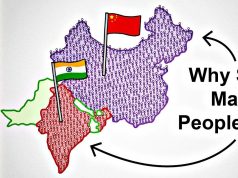Aprendendo inglês com vídeos é uma série de posts em que traremos para vocês vídeos acompanhados de transcrições e traduções, pois este é um material de altíssima qualidade para qualquer estudante de inglês. A grande maioria dos vídeos virão do YouTube, assim como forma de retribuir aos criadores dos vídeos incríveis que vamos usar, pedimos que você sempre dê o seu “Gostei” no vídeo (ao clicar para reproduzir o vídeo você verá a opção “gostei” no próprio vídeo).
What Makes the Great Wall of China So Extraordinary (Transcrição)
A 13,000 mile dragon of earth and stone winds its way through the countryside of China with a history almost as long and serpentine as the structure. The Great Wall began as multiple walls of rammed earth built by individual feudal states, during the Chunqiu period to protect against nomadic raiders north of China and each other.
When Emperor Qin Shi Huang unified the states in 221 BCE, the Tibetan Plateau and Pacific Ocean became natural barriers, but the mountains in the north remained vulnerable to Mongol, Turkish, and Xiongnu invasions. To defend against them, the Emperor expanded the small walls built by his predecessors, connecting some and fortifying others. As the structures grew from Lintao in the west to Liaodong in the east, they collectively became known as The Long Wall. To accomplish this task, the Emperor enlisted soldiers and commoners, not always voluntarily.
Of the hundreds of thousands of builders recorded during the Qin Dynasty, many were forcibly conscripted peasants and others were criminals serving out sentences. Under the Han Dynasty, the wall grew longer still, reaching 3700 miles, and spanning from Dunhuang to the Bohai Sea. Forced labor continued under the Han Emperor Xuandi, and the walls reputation grew into a notorious place of suffering. Poems and legends of the time told of laborers buried in nearby mass graves, or even within the wall itself. And while no human remains have been found inside, grave pits do indicate that many workers died from accidents, hunger and exhaustion.
The wall was formidable but not invincible. Both Genghis and his son Khublai Khan managed to surmount the wall during the Mongol invasion of the 13th Century. After the Ming dynasty gained control in 1368, they began to refortify and further consolidate the wall using bricks and stones from local kilns. Averaging 23 feet high and 21 feet wide, the walls 5500 miles were punctuated by watchtowers. When raiders were sighted, fire and smoke signals traveled between towers until reinforcements arrived. Small openings along the wall let archers fire on invaders, while larger ones were used to drop stones and more. But even this new and improved wall was not enough.
In 1644, northern Manchu clans overthrew the Ming to establish the Qing dynasty, incorporating Mongolia as well, Thus, for the second time, China was ruled by the very people the wall had tried to keep out. With the empire’s borders now extending beyond the Great Wall, the fortifications lost their purpose. And without regular reinforcement, the wall fell into disrepair, rammed earth eroded, while brick and stone were plundered for building materials. But its job wasn’t finished. During World War II, China used sections for defense against Japanese invasion, and some parts are still rumored to be used for military training. But the Wall’s main purpose today is cultural.
As one of the largest man-made structures on Earth, it was granted UNESCO World Heritage Status in 1987. Originally built to keep people out of China, the Great Wall now welcomes millions of visitors each year. In fact, the influx of tourists has caused the wall to deteriorate, leading the Chinese government to launch preservation initiatives. It’s also often acclaimed as the only man-made structure visible from space. Unfortunately, that’s not at all true. In low Earth orbit, all sorts of structures, like bridges, highways and airports are visible, and the Great Wall is only barely discernible. From the moon, it doesn’t stand a chance. But regardless, it’s the Earth we should be studying it from because new sections are still discovered every few years, branching off from the main body and expanding this remarkable monument to human achievement.
What Makes the Great Wall of China So Extraordinary (Tradução)
Um dragão de 13.000 milhas de terra e pedra, segue seu caminho através dos campos da China com uma história quase tão longa e serpentina quanto a estrutura. A grande muralha começou como múltiplas muralhas de taipa construídas por estados feudais individuais, durante o período Chunqiu, para proteger contra saqueadores do norte da China e contra uns aos outros.
Quando o imperador Qin Shi Huang unificou os estados em 221 A.C, o Platô Tibetano e o Oceano Pacífico, se tornaram barreiras naturais, mas as montanhas do norte permaneceram vulneráveis aos mongols, turcos e as invasões Xiongnu. Para se defender deles, o imperador expandiu os pequenas paredes construídas por seus antecessores, conectando algumas e fortificando as outras. Como a estruturas cresceram de Lintao, no oeste, até Liaodong, no leste, elas coletivamente se tornaram conhecidas como A Longa Muralha. Para realizar essa tarefa, o Imperador recrutou soldados e civis, nem sempre de forma voluntária.
Das centenas de milhares de construtores registrados durante a dinastia Qin, muitos foram camponeses recrutados forçadamente e outros eram criminosos cumprindo sentenças. Na dinastia Han, a muralha cresceu mais ainda, alcançando 3.700 milhas se estendendo de Dunhuang até o Mar Bohai. O trabalho forçado continuou sob o comando do Imperador Han Xuandi, e a reputação das muralhas se tornou em um notório lugar de sofrimento. Poemas e lendas da época, falavam de trabalhadores enterrados em valas comuns nas proximidades ou mesmo dentro da muralha. Enquanto nenhum resto humano foi encontrado dentro, poços de sepultamento indicam que muitos trabalhadores morreram de acidentes, fome e exaustão.
A muralha era formidável, mas não invencível. Tanto Genghis quanto seu filho Khublai Khan, conseguiram transpor a muralha durante a invasão mongol do século 13. Depois que a dinastia Ming ganhou controle em 1368, eles começaram a refortificar e consolidar ainda mais a muralha, usando tijolos e pedras de fornos locais. Com cerca de 23 pés de altura e 21 pés de largura, as 5.500 milhas da muralha foram pontuadas com torres de vigia. Quando saqueadores eram avistados, sinais de fogo e fumaça viajavam entre as torres até os reforços chegarem. Pequenas aberturas ao longo da muralha, permitiam archeiros dispararem contra os invasores, enquanto as largas eram usadas para derrubar pedras e outros. Mas mesmo essa muralha nova e melhorada, não foi o suficiente.
Em 1644, clans Manchu do norte, derrubaram os Ming, para estabelecer a dinastia Qing, incorporando a Mongolia também. Assim, pela segunda vez, a China foi governada pelas primeiras pessoas que a muralha tentou manter afastadas. Com as fronteiras do império agora se extendendo além da grande muralha, as fortificações perderam seu propósito. Sem o reforço regular, a muralha se tornou em ruínas, taipas corroídas, enquanto os tijolos e pedras foram saqueadas para materiais de construção. Mas seu trabalho não tinha terminado. Durante a segunda guerra mundial, a China usou as seções para se defender contra a invasão japonesa, e há rumores de que algumas partes ainda são usadas para treinamento militar. Mas o principal propósito da muralha hoje, é cultural.
Como uma das maiores estruturas construídas pelo homem na terra, ela foi admitida com o status de patrimônio mundial da UNESCO em 1987. Originalmente construída para manter as pessoas fora da China, a grande muralha agora dá as boas vindas a milhões de visitantes todo ano. Na verdade, o afluxo de turistas tem feito a muralha se deteriorar, levando o governo chinês a lançar iniciativas de preservação. Ela também é frequentemente aclamada com a única estrutura construída pelo homem, visível do espaço. Infelizmente, isso não é totalmente verdade. Em órbita terrestre baixa, todos os tipos de estruturas como, pontes, rodovias e aeroportos, são visíveis, e a grande muralha é somente quase imperceptível. Da lua, isso não tem a menor chance. Mas independente disso, é da terra que nós deveríamos estar estudando a muralha, porque novas seções ainda são encontradas a cada poucos anos, ramificando-se do corpo principal e expandindo esse monumento memorável para a realização humana.
Espero que vocês tenham gostado do vídeo de hoje e da transcrição/tradução! Como sempre, não deixem de visitar o vídeo no Youtube e dar o seu “gostei”, pois assim vocês estão ajudando o trabalho dos criadores desses vídeos incríveis! Link para o vídeo no YouTube: https://www.youtube.com/watch?v=23oHqNEqRyo Abração e bons estudos a todos vocês
!










